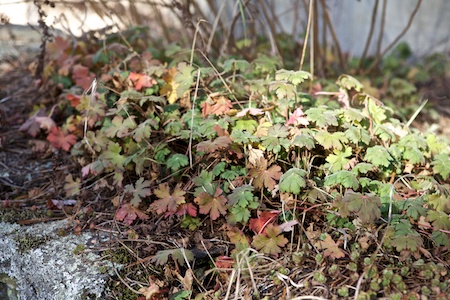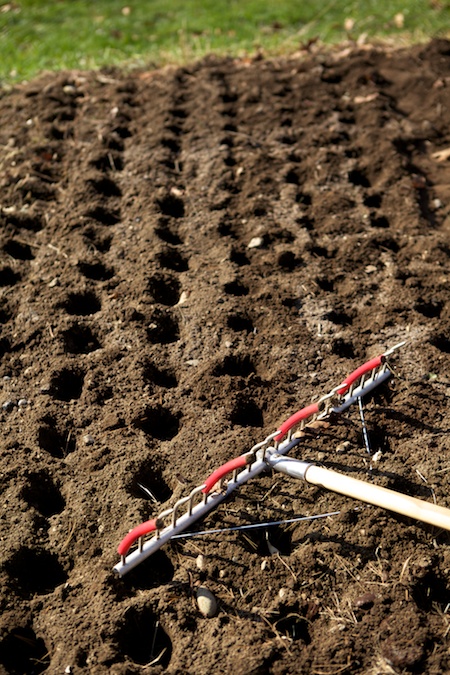Duck Potatoes
If you remember, we added some ducks to Chiot’s Run back in October. When we traveled back to Ohio for Thanksgiving, we left them in a heated room in our garage. They still weren’t fully feathered and we hadn’t trained them to the electric fence, so we figured it would be the safest place to leave them. When we left they were still ducklings, we arrived home to BIG DUCKS!


Not only were they big ducks, they had gotten lazy in their cushy indoor days. When I would open the garage door to let them out to forage, they wouldn’t leave the garage. After two days of this, I finally decided it was time to withhold their food. A hungry duck is one that will go outside in search of food. Low and behold, it worked! Now they’re out and about much of the day eating dandelions and clover in the lawn.


The good thing is, they have now been trained to see an indoor place as a safe place and a place to sleep. I think this will be greatly help in our efforts to keep these guys safe from predators. I don’t have to herd them inside at night, they go in on their own. If they start trying to stay outside, they’ll be herded inside. We’ve already been working on our herding with them, it’s really quite easy with a flock of ducks!


They’re not quite fully feathered and they’ll still get bigger than they are now. Muscovies are pretty large ducks. The good thing is that they’re very hardy, the cold doesn’t seem to be bothering them at all. They’re so entertaining, we really get a good laugh from them quite often. They seem quite curious and love watching us working outside, here they are paying close attention to Mr Chiot’s coffee roasting to see if they can pick up any tricks.


We’re still in the process of building our duck house, we’ve been slightly busy with our work after taking a week and a half to travel to Ohio. Hopefully they’ll be living in their new digs by Christmas.
Have you ever had to deal with lazy pets?
Filed under Around the Garden | Comments (18)Moving a Hedge
If you were reading the blog last year, you might remember that I finally realized a garden dream when I added a 60 ft boxwood hedge to my garden. I must admit, I was a bit sad to leave my hedge behind, but figured I’d simply start anew next spring.


Much to my delight, the new owners of our home in Ohio aren’t gardeners and told us to take whichever plants we wanted. So the hedge came with me. It’s a bit late to be moving these beauties, but I figured I had nothing to lose but a few hours of time.

I dug each shrub carefully with a large root ball and planted them in the big upper edible garden. They’ll be mulched heavily with some leaves and I’ll pile lots of pine boughs around them for added protection this winter. Each of these shrubs would have cost me about $70 to replace so I figured it was worth a an hour or two of my time to try to save them.


If these beauties survive the winter, they’ll most likely become a hedge around the small potager behind the house. It will be nice to have a few of my favorite plants from Ohio here in Maine!
What’s your favorite hedge plant?
Filed under Around the Garden | Comments (13)The Tour: The Gardens
One of the reasons we chose this property was because of the potential that it had as far as gardening was concerned. The gardens are off to a good start, I’ll definitely be expanding them every year.


We’ll start off with the foundation gardens around the house. I know there are poppies, goat’s beard, asters and a few other things growing here. The previous owner took some of the plants, which is fine with me. It will certainly be interesting to see what pops up next year.



In the front lawn, there are two ancient apple trees surrounded by a fairly lush lawn. No doubt all the chicken poo helps, since the chickens are very fond of scratching around under these trees.

There’s a small potager behind the house, it’s probably a 15 ft square. I’ll be expanding it a bit, building rock walls along the bottom edge to retain the soil, and giving it a formal feel with a four square plan.

There’s also a raised bed nested into the hillside in the back of the house. It’s above the small potager.

Up behind the garage, there’s a large main edible garden. It’s currently planted in cover crops and a few overwintering vegetables. I have big plans for this area next spring, hopefully I’ll be able to put those chickens to work tilling it up and getting rid of some of the grassy weeds.


There’s also an old fashioned out house, complete with bucket of ash sitting over a small hill across the driveway. I suppose this could come in handy should we have big garden parties some day.

There’s also a wood fired sauna sitting down below the house. We haven’t had time to fire it up yet, hopefully we will use it often this winter. It’s a sweet little building to be sure.

There are vast grassy areas around the house, they’ll be frost seeded with clovers and beneficial pasture plants in hopes that it will be well established for some hoofed friends someday. There’s also a large hillside in front of the house that’s completely cleared, we may terrace it and turn it into a permaculture garden. There’s no shortage of possibilities here at the new place, our only limitations will be time and money! It’s a good things we’re patient people.
What’s your favorite foundation garden plant?
Other Stops on the Tour:
The Driveway
The Tour: Chicken Coop
The Tour: The Chicken Coop
No doubt you’ve seen glimpses of the chicken coop here and there but not in it’s entirety. From what I understand, this coop used to be the shed. It was then converted to a coop. A wooden structure in it’s natural form, it nestles quite easily into it’s surroundings and looks right at home.

It’s quite rustic and charming, buttoned up well against predators to keep the chickens safe and sound. Thankfully, there is an attached run, which is very nice because we can leave the chickens for a while without worry (though we do have the neighbor come check on them when we do).

There’s storage on one side, it came pre-filled with a variety of feeders, waterers and other interesting things, some of which we are not quite sure what they are for, no doubt we’ll figure it out.

The interior is good enough for the chickens, though we might reconfigure a bit to make cleaning a little easier. The ladies seem to like it well enough as is.

We need to build a few new nesting boxes for them, these are showing their wear. The chickens don’t seem to mind, though with the waning daylight hours and molting they’re not laying much at the moment.

In the spring, I plan on whitewashing the walls and scrubbing up the windows to brighten it up. If I have time, I may try to tackle the windows yet this fall. I’m sure the chickens would appreciate the extra sunlight!

Someday we might end up building a newer larger coop, but this one is quite functional until we do. It will most likely be used as a breeding coop if we go that direction. It’s certainly nice to have such a structure already in place. Now we can focus on other infrastructure like planting lots of fruit trees and other forage for the chickens. Next year we plan on getting a whole flock of new chickens as well.
Do you have any recommendation for a variety of chicken for us to get next spring?
Other Stops on the Tour:
The Driveway
The Tour: Chicken Coop
Neat and Tidy
I’m a big fan of the traditional rowed vegetable garden, perhaps it’s my inner tendency to OCD rearing it’s head. Usually, I try not to be too crazy about spacing, though I do like to use my square foot gardening templates to keep things neat. When you’re doing long rows of vegetables it can be tough to keep those rows straight.

Earlier this fall, I purchased a seed bed preparation rake from Johnny’s Seeds along with the little pieces of tubing for row marking. I must say, I LOVE THIS TOOL. It’s super wide, thus allowing me to prepare a large area very quickly. I also love the little plastic tubes, they can be put on different tines depending on the spacing you want.

This tool makes seeding an entire bed while keeping the lines straight go very quickly. I’m really looking forward to using this in the spring for nice rows of beets, carrots, and lettuce! Although my grandpa always did say, “You can fit more in a crooked row.”
When it comes to the vegetable garden, do you like neat straight rows or do you like things a little more natural?
Filed under Around the Garden | Comments (19)
